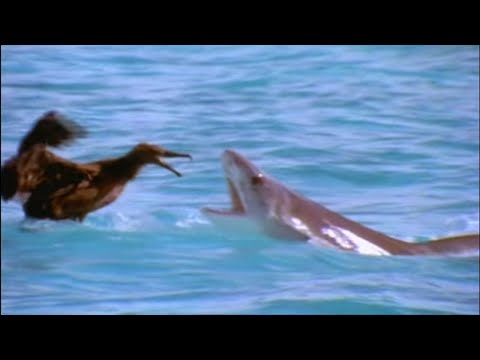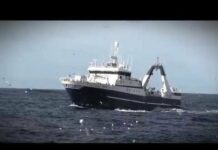Following the scavenger sharks that live off the remains of their aquatic neighbours, from the remnants of a blue whale to fins and fur. Filmed over four years in New Caledonia.
Author(s): Cyril Barbançon, Bertrand Loyer
Director(s): Cyril Barbançon, Bertrand Loyer
Year: 2003
Producer(s): Saint Thomas Productions, Canal+
Running time: 52 mn
Distributor(s): Village Distribution
Awards:
Japan Wildlife Film Festival
Japan, 2003
Best Underwater Film –
Follow us on social media :
Facebook : https://www.facebook.com/BestDocumentaryTV
Their playground, the Pacific Ocean. Lording it over such a vast kingdom, they cut an all-too-familiar silhouette. Their popular reputation as fierce predators is understandable. Yet, what are they but common scavengers? The humble dustmen of the seas, and all too often, outsmarted by their juniors. Here are sharks in their true colors. The Pacific is by far the largest body of water on the planet. Covering 70 million square miles,.
It accounts for half the world's ocean surface. Lost in this blue kingdom, pinpricks of land where young seabirds are about to leave their nests for the first time. A fact not lost on life below the reef that encircles the tiny islands of the French Frigate Shoals in northwestern Hawaii. After weeks of training, black-footed albatross chicks are ready for the big day. Their parents have already left the nesting ground. Even the strong wind blowing off the lagoon.
Can't help this one. It's fair game for the most opportunistic predator in the lagoon, the tiger shark. It's both unpredictable and extremely aggressive. Unlike other species of sharks out to sea, the tiger shark is generally a loner whose favorite hunting grounds are the shallows. Nothing like a nudge in the right direction to get airborne. It wasn't to be. The chicks will try to take off in unison.
So the tiger shark only has a narrow window of opportunity for playing, feasting, and saving its awesome reputation. In the open sea, sharks and birds behave in an altogether different way. Every kind of ocean nomad is drawn by the strong winds and currents that galvanize the sea into a maelstrom of competing interests, both above and below the surface. How are these pristine opal waters managed, or serviced, if you like? Like the tiger shark policing the shallows alone, nomads out here work together towards a common objective,.
Be it for defense or attack. Schools of baitfish bunch together for protection. They're being rounded up by a pod of bottlenose dolphins. The table is laid. Wait a moment. Unexpected guests have shown up, and the dolphins must leave the table. Silky sharks. They've been watching the dolphins work from a distance.
Their vision finely attuned to the blue gloom because of special pigments in their eyes. The dolphins sensibly wait for a second sitting, which they'll share with others on the surface. Gannets and brown petrels enjoy a bird's-eye view, but their patience is wearing thin. Now that the waters have been tested, a full aerial bombardment is underway. These feathered torpedoes must climb to ten meters before executing their spectacular sorties.
This extraordinary assault by shark and bird against the bewildered baitfish is relentless. Having taken the lion's share, the silky sharks withdraw as willfully as they came. It's a moment of respite for the baitfish, but not for long. Yellowfin tuna form a third front, wave after wave of them. This is predation on a massive scale. The remaining baitfish have one last card to play.
They swarm individual silky sharks, not for revenge, but for protection against the tuna. The baitfish face a dilemma. Should they jump ship from shark to tuna? The silence of this predatory world speaks for itself. There are areas of the Pacific where natural predators turn to scavenging for a living. The main island in the archipelago of New Caledonia is a sliver of land in the South Pacific, 250 miles long and 30 wide.
Smaller islands bathe in the crystal clear waters of a tropical lagoon. The largest lagoon in the world, 9,000 square miles. It's a paradise meticulously tended by those who inhabit it. No paradise is one without sacrifice. Those who share it share off each other too. Everywhere life thrives, death will reap a just reward. The lagoon creates waste and must dispose of it. One day, the dead and the wounded will be mopped up by scavengers.
The dustmen of the seas. The lagoon is not impenetrable. Cracks are opened up in this vast ring of coral by the relentless pounding of the ocean. The whitetip reef shark is an expert dam buster. A red snapper snared in a net. The shark hones in on the distress signals as the snapper emits a faint electrical charge, even when it's motionless.
Literally a millionth of a volt is enough to stimulate sensory organs called ampullae of Lorenzini on the shark's snout. In effect, the injured and the weak sign their own death warrant. A grey reef shark approaches the industrious whitetips keen to join operation cleanup. Its impressive size does not earn it the automatic right to muscle in. This is a private party for whitetips only. Sharks themselves also run the risk of getting caught in nets, particularly those more used to inhabiting the open sea.
But white tip reef sharks are equipped with two rows of teeth. The uppers are triangulated and jagged. The lower row, narrow and sharp. A perfect combination for cutting and tearing their way out of trouble. Damaged teeth will be replaced in 18 days, and they'll grow about 20,000 new teeth in the course of their lives. As long as whitetip reef shark move freely and hunt in packs, neither nets nor other sharks will stop them in their mission to clean up the lagoon of injured and weak fish.
Inadvertently, the sharks will even help dismantle these destructive nets. This snapper might count itself lucky. If only it could hide its distress. The more it struggles to stay afloat, the stronger the signal. Thanks to the shark's natural radar and its capacity to detect vibrations from far, the area is cleared. Pockets of coral and limestone caves do offer some insulation from this radar, which, it must be said, is only used at short range. But what is this one after?.
A swimming wrasse which emits long-range vibrations. Whitetips will go to great lengths to satisfy their appetite, or is it just curiosity? After all, they need only feed every other day and a mere three percent of their body weight is reckoned a good enough meal. Some fetch up at the mouth of a cave through a break in the reef, a good place for an ambush. Unlike their cousins in the open water,.
Whitetips don't need to be on the move to breathe. They can lie and wait for their prey by using muscular contractions to pump water through their gills. These males aren't hungry for food, but sex. They're waiting for a female. She's hemmed in on all sides by competing males, but the paramour must fend off other excited rivals. The lovemaking will last about five minutes, during which time the suitor must fend off other rivals drawn into the scene.
By the vibrations and electrical impulses radiating from the courtship. The female probably got off lightly. This one is unlikely to survive. Her blood involuntarily signals her vulnerable condition to every pilferer in the area, including the biggest fish in the world, the whale shark. It's 15 meters long, and quite harmless. Like real whales, the whale shark is a filterer.
Using its cavernous jaws to hoover up plankton and other small fry in its path. It too, is a most efficient cleaner, though quite incapable of cleaning up a dying shark. Commotion, blood, electricity. The telltale distress signals radiate loud and clear. This silvertip has homed in from the bottom of the pass. A welcoming committee is awaiting. The red snappers are back,.
And so are the grey reef sharks. These passing bottlenose dolphins and their calves steer clear of the danger. A silvertip this size is also a potential threat to baby dolphins. The shark must be seen off. Indeed, the dolphins take it in turns to go up to the surface to breathe. The tactic is ingenious. The dolphins spiral around the silvertip to force him down out of harm's way.
Reinforcements are called in to increase the pressure. It's now five against one and the silvertip finally gets the point. The dolphins can't disguise their delight. It's time to surface and celebrate. The pass through the reef is now clear and the dolphins are free to enter the shallows and explore the waters around the sandy islands. As spring turns to summer in the Southern Hemisphere, a time-honored pilgrimage is about to wash up on these shores.
Same time, same place. A green turtle scarred by a long journey. The healthy ones will perpetuate the species as they have done for 15 million years. An annual rendezvous for mating and for the females to lay eggs. The event is also on the calendar of the blacktip shark. At high tide, it watches greedily as the females prepare to beach. The solitary turtles have crossed the Pacific with pinpoint accuracy.
Thanks, it is thought, to some magnetic minerals in their brain which tap into the Earth's magnetic field for direction. The tide fills natural pools around the beachrock, allowing the sharks to get close to shore. A female, all 80 pounds of her, hauls her eggs far from the high water mark, more than a kilometer inland. The sharks know the routine. They'll patrol the pools until the tide flushes them out again. The turtles have 12 hours to dig and fill their nests.
Before catching the next high tide out. As the tide goes out, sand crabs also dig in for a night of hunting. As night falls, blacktips still brush the shoreline. Grey reef sharks patrol further out at sea. A blockade is on. With the tide now low, some turtles have finished laying their eggs. A blanket of sand will keep them at a constant temperature.
And hide them from predators during a two-month period of incubation. The females now begin the arduous return journey. By morning, most have left on the high tide. Those that have missed it must face a punishing wall of exposed coral under the baking sun. All after an exhausting night's work. It's the end of the road for this one. Her carcass now reeks of rich oils and torn flesh. On cue, gray reefs and blacktips follow their noses.
To locate dead prey, these scavengers are guided by their sense of smell. Reclusive hermit crabs are left to polish the silver. By mid-summer, the dry season has set in on the main island of New Caledonia. A mountain range on the Leeward Coast creates long periods of drought. It's home to tens of thousands of wild deer who now look elsewhere for green pasture. Some head for the mangroves. Many will leave the island altogether.
And venture across the bay in search of food on other islands. Their narrow hooves are ill-suited for swimming. Hopefully, the natural buoyancy of their paunch will keep them afloat. The deer can average two knots over long distances, simply by repeating the same movements they use on land. Across the lagoon in any direction, lie dozens of tiny uninhabited islands. They're thick with grasses and foliage supplied all year-round by soft water trapped in the limestone subsoil. The crossing has been worthwhile, even if some of the deer have struggled.
Two miles from the mainland to find new feeding grounds. They'll spend the entire summer island hopping to survive the drought. Every day brings new arrivals. This kid is exhausted, but at least he's made it. Many die in midstream. Waste to be disposed of by the dustmen of the seas. A mere one part blood to 100 million parts water is enough to trigger a frenzy. By the end of the summer,.
The last of the nesting turtles are leaving the islands. Hundreds of eggs are ready to hatch. Instinctively, the baby turtles head for the pool. There's no scent of blood this time. Here, the blacktips must use their eyes, if their patience is to be rewarded. This is a problem because they're short-sighted and their movements are cramped by the shallow waters. In the event, the sharks are joined by other, faster and more efficient predators.
Giant trevally. More commonly known as Jack. Pound for pound, it's the strongest fish in the world, sharks included. It's perfectly suited to the crystal clear and well-oxygenated shallows. This is the proof. By contrast, it takes two myopic and clumsy blacktips to hunt down a single baby turtle. Those which survive the blockade to the open sea.
Must now contend with predators from the sky. What with these terns, sharks, and the jacks, it's little wonder that out of 100 eggs, only one turtle will survive to adulthood. If this is one of them, it will be back in 15 years to mate or lay eggs. The scavengers will make a point of being there too. For the most part, life about the lagoon is entirely predictable. Here is a magnificent exception. An 18-meter blue whale.
The largest animal ever to roam the planet. At the end of the southern summer, this male should be feeding on krill in the Antarctic, but it's lost its way and mysteriously fetched up in the lagoon. Never has this been seen before in New Caledonia. Stretch marks are signs of severe undernourishment. If the lagoon can't satisfy its needs, perhaps it can satisfy others'. Forty tons of flesh emit rapid, low frequency sound waves. The tiger shark has picked up the signal from several miles away.
As the whale reaches the bottom of the bay, exhausted and cornered. In the end, there is only one killer. What a treat. Rare indeed for this tiger shark to have honed in on so much red meat. It has pushed itself to the limit and has swallowed a tenth of its own body weight. Other sharks were probably too far off in the lagoon to make it in time, but the blue whale is going no further. Day after day, the whale's corpse will radiate a gigantic, oily path.
Sharks and their stereoscopic sense of smell will simply follow this stairway to heaven. This treasure of protein has been bagged by a whole pack of tigers, and they won't let any other species of shark near it. Only a few harmless remoras are tolerated. The final cleanup is underway. It has taken a week and counting to clear all 18 tons of meat. What little evidence is left of the blue whale will filter through passes in the lagoon for the final clean.
In the dark abyss of the open sea. About 85 percent of the Pacific is more than a mile deep. Plenty of room for other, more passive scavengers waiting in the dark and cold and under colossal pressure for the pickings left by their peers on the surface. Down here, life exists without oxygen. Deep sea hydrothermal vents sustain an oasis of life. Located on the side of a fault between two tectonic plates, New Caledonia is effectively a mountain in the ocean.
These gigantic fractures in the crust belch gases through seafloor chimneys. In this anaerobic and unstable underworld, life is organized around methane and hydrogen sulfide, highly toxic on land, but life-sustaining in the abyss. At the bottom of the evolutionary pile in this ecosystem is the tube worm. It has no mouth, no digestive tract, and no anus. Everything is passed through its plumes. The thermal vents superheat the water to 350 degrees Celsius, but at depths of 3,000 meters, the water does not boil.
The pressure is too great. So blind shrimps are free to scrape the vents for minerals and bacteria. It's remarkable how marine life can adapt to this hell. Away from the vents, notably at the foot of the New Caledonian lagoon, there is nothing. Life in these abyssal deserts depends essentially on what sinks from the surface. When scavengers of the dark reach their objective,.
Relationships can be extremely long-lasting. Giant crabs will take several years to pick a whale carcass clean. Difficult to be spotted in this dark world, unless like some squid, you are equipped with photophores, a sort of light-producing organ. They use them to attract prey or to seduce sexual partners. These luminous cells can also be seen on dying animals. Others must grope their way around the ocean floor in their search for organic matter, dead or alive.
It's a task made easier for the birdbeak dogfish, and like its cousins from the lagoon, its stereoscopic sense of smell. Other scavengers must wait for the currents to carry food to them. Like this tripod fish. They can also filter organic particles like this swimming sea cucumber and these crinoids. The vampire squid uses sensory cilia to detect what's edible in the ocean swells. What do we have here?.
The most prized dish in the abyss. A whole whale. It's covered with hagfish. These living fossils have been around for five million years, long before any other fish. They're vertebrates with no eyes, no skeleton, no scales, not even a mouth. They do have an external circle of teeth and a strong sense of smell. But a million hagfish can't match this. The Pacific sleeper shark,.
Indolent and sluggish by nature, but very greedy. Seven meters long and weighing two tons, it's the largest of all deep water fish and it has an insatiable desire to keep a 300-liter stomach comfortably full. Most life around the lagoon in New Caledonia ends up in the abyss. Even the oceanic whitetip sharks are destined to become a meal for the galatheid crabs. One dustman feeds off another. A fitting end for the scavengers of the seas.
We are excited to present to you the captivating video titled “Scavengers of the Seas – Documentary”. Get ready to embark on a journey of enjoyment, smiles, and laughter as you watch this delightful creation. “Scavengers of the Seas – Documentary” is a perfect blend of entertainment and amusement, carefully crafted to bring joy to your day. From the moment you press play, you’ll be greeted with a cascade of lighthearted moments, heartwarming scenes, and perhaps even a few surprises that will tickle your funny bone.
Whether you’re in need of a quick pick-me-up or simply looking for some light-hearted entertainment, “Scavengers of the Seas – Documentary” has you covered. The video promises to deliver a collection of moments that are bound to leave you grinning from ear to ear. With its engaging content and skillful presentation, “Scavengers of the Seas – Documentary” is more than just a video – it’s an experience designed to brighten your mood and spread positivity.
The creators of “Scavengers of the Seas – Documentary” have poured their creativity and dedication into crafting a visual treat that resonates with audiences of all ages. Through expert storytelling, impeccable timing, and an array of engaging content, “Scavengers of the Seas – Documentary” promises to be an unforgettable journey that lingers in your memory long after the video concludes.
So sit back, relax, and prepare to be entertained as you dive into the world of “Scavengers of the Seas – Documentary”. It’s a delightful video that aims to bring a dose of happiness to your day, leaving you with a lasting smile and a heart full of laughter.
This video was uploaded in youtube and has recieved 5069484 views so far. This is a great achievement and laso it has received 14240 likes and .
Data bout the video:
Rating: ,
Video dimensions: 2d,
Video definition: sd,
Video duration: 00:49:36,
Video favourite count: 0
Video comment count: 270























